- Best Grass Seed for Clay Soil - April 3, 2022
- Seashore Paspalum Guide – Warm-Season Grass - January 30, 2022
- Best Grass Seed for South Carolina - January 20, 2022
While mulch might not be the solution to all of your garden troubles, garden experts and arborists say it can go a long way when it comes to fixing your yard. Mulch consists of a wide range of materials that all have one important function—improving the condition of the soil.
While mulching may be considered a basic gardening task, there are a few things you must know about the different types of mulch that exist and the benefits of mulch. Knowing why you should use mulch and what you should look for in mulch is also vital for ensuring that your plants stay healthy.
Keep the advice below in mind while you’re planting during spring and throughout the whole year, particularly if you want to do some landscaping or add new beds.
Benefits of Mulch
When you looking for the right mulch for your landscape or yard, figure out its purpose. All types of mulch provide the following benefits.
Beautification: Mulch helps improve the appearance of the different areas of your landscape.
Moisture retention: Mulch decreases the loss of moisture from evaporation.
Soil insulation: Mulch helps protect root systems from the extremes of temperature.
Weed reduction: Mulch helps block the light certain weeds require to germinate. Also, it hinders the growth of weeds that actually sprout. Some mulch brands include an herbicide for added weed control.
Erosion control: Mulch keeps the soil intact.
Understanding the Different Types of Mulch

Mulch comes in two basic forms: organic and inorganic mulch.
Organic mulches consist of previously living material, including chopped leaves, grass clippings, straw, wood chips, compost, sawdust, pine needles, shredded bark, and even paper. On the other hand, landscape fabrics (geotextiles) and black plastic are some examples of inorganic mulch.
Both forms of mulch keep weeds at bay, but organic mulch also improves the soil since it decomposes. Inorganic mulch neither decomposes nor benefits the soil, but this doesn’t necessarily mean it’s not a good choice for your garden.
For example, a popular type of inorganic mulch like black plastic keeps the soil warm and radiates heat at night, keeping heat-dependent vegetables like cherry tomatoes and eggplant cozy and vibrant.
Organic Mulch
This type of mulch is made of naturally occurring materials like manure, straw, wood, and stone. If you want a 100% natural garden, then you should go for organic mulch. This mulch is also easy to find and inexpensive—two huge advantages if you need your garden fixed quickly. One of the major drawbacks of organic mulch is that it needs to be replaced more often than inorganic variants.
Organic mulch choices include:
- Compost and manure
- Stone or gravel
- Straw
- Bark or wood chips
Inorganic Mulch
This kind of mulch is synthetic, made from products like plastic or landscape fabric. In general, inorganic mulch is costlier than its organic counterparts. Since inorganic mulch lasts much longer than a single season, this more than makes it up for the cost difference.
Inorganic mulch choices include:
- Rubber
- Landscape plastic
- Landscape fabric
Types of Mulch to Use in Your Garden

Depending on what you’re planting and your landscape design, each of these mulch options can be a good choice.
Grass Clippings
This is a readily available mulch, even though it’s wise to save some clippings for use as an organic lawn fertilizer. If you have grass clippings remaining, use them as mulch since they’re a rich source of nitrogen for your vegetable garden.
Shredded Leaves or Wood Chips
You can buy bags of decorative shredded bark or wood chips from a nearby garden store to mulch your shrub borders and flower garden. For an inexpensive option, contact your local utility or tree care service to see if they’ve got any spare wood chips readily available. Or if you like to plan ahead, cut your Christmas tree into pieces instead of chucking it away.
If you’ve got trees at home, chopping the fallen leaves makes a nutrient-filled mulch at no additional cost. You also don’t need any special machine to do this: a lawnmower that comes with a bagger will gather the leaves and chop them into the right size for mulching.
You can spread shredded leaves or wood chips mulch anywhere in your garden, but it looks perfect in garden pathways, shrub borders, and flower beds. But bear in mind that wood chips aren’t a good choice for annual flower and vegetable beds as they’ll get in your way while you dig each year.
Straw or Hay
When planting vegetables, consider covering the garden with weed-free hay, salt hay, or straw. It not only looks crisp and clean, but this kind of mulch also prevents weeds, retains soil moisture, and gives the soil organic matter once it decomposes.
Just make sure to use seed- and weed-free hay, and avoid heaping it around fruit tree trunks or vegetable stems to prevent rodent and slug damage.
Compost
You can also use your compost as mulch. It’ll add nutrients to the soil and keep your plants healthy. But bear in mind that dry mulch is harmful to plant roots, so be sure to spread a thin layer of compost around plants and add another mulch on top, like chopped leaves.
This lets the compost retain moisture and stay biologically active, giving your fruits, vegetables, and flowers maximum benefits.
Landscape Fabrics
Landscape fabrics, aka geotextiles, allow water and air into the soil underneath while keeping weeds at bay. However, this mulch has some downsides. When geotextiles are exposed to light, they gradually degrade. To ensure that they last longer, add another mulch on top (they’re ugly, after all, so you should be happy to do so!).
Keep landscape fabrics off shrubs. Shrub weeds and roots grow into the geotextile, which means you’ll need to rip up the geotextile once you remove them.
Plastic Mulch
Mulching your vegetable garden with black plastic films can work miracles. When it’s tightly spread over a smooth surface of the soil, black plastic sends the heat of the sun to the soil underneath, creating a microclimate that’s around 3°C warmer than your unmulched garden.
Since the plastic films stay dry and warm, this prevents the fruits of crops like cucumbers, melons, and strawberries from rotting. And, the mulch definitely retains soil moisture and prevents weed growth.
River Rock and Stones
Rocks are usually costlier than organic types of mulch. But since they’re inorganic materials, stones, landscaping pebbles, and river rock don’t decompose, so you don’t need to reapply them every year. But this also means they won’t eventually improve your soil.
Take care when mulching with stones since the sun often makes them really hot. Stones are normally used in rock and cactus gardens. If you opt to mulch with stones and rocks in a place where plants will not be growing, like under a deck, make sure to first cover the soil with sheer landscape fabric to prevent weeds from sprouting through the rock.
Types of Mulch Colors
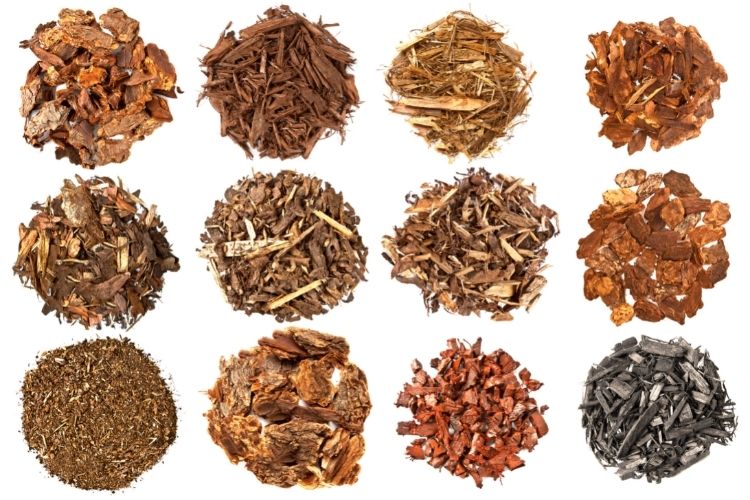
Organic mulch is available in natural colors like reddish browns and browns, but these colors fade away as the mulch wears out. Mulch with extra color provides you with longer-lasting color and more design options. Available in red, brown, and black, organic mulch can create attractive patterns in your yard. Think about your plants’ foliage and blossoms, as well as your home’s color. Here are a few tips on how to apply mulch colors.
Red mulch gives your landscape an attractive and unexpected feature. It complements your lawn’s green, as well as the foliage of your bedding plants, trees, and shrubs. It also looks perfect around lighter-colored plants.
Brown mulch also complements various plant colors and serves as an amazing background for the green vegetation. It gives a natural look and blends into the topography. Depending on the brown tint, it can even replicate the appearance of the soil.
Black mulch also mimics the natural appearance of some soil types. It provides a vivid contrast to white blossoms and may work perfectly with a modern-looking home. Compared to other colors, black mulch also absorbs more heat. Depending on your plants and climate, this can be a benefit or drawback.
Aside from prepackaged red, brown, and black mulch, you can use DIY mulch dyes to create mulch colors.
Keep in mind that color choices aren’t the preserve of organic mulch. There are also many different colors of inorganic mulch, including lava rock and red brick nuggets, black-red, brown and white marble, green rubber mulch, and many others.
How to Find the Right Mulch for Your Needs
The best mulch option from the different kinds of mulch available depends on the kind of project you’re undertaking and your taste, especially in terms of selecting mulch colors. For every project, take these factors into account.
Your Project’s Size
The various kinds of mulch on the market can vary considerably in price. The cost of the various mulch options and scale of your project can help you select the right mulch for your garden.
Mulch Longevity
Most types of organic mulch last for one season and some last for a whole year. Inorganic mulches, such as rubber mulch, will last much longer. Figuring out how long your mulch should last will help you choose the right option for your yard.
Weed Prevention
All kinds of mulch may help prevent weeds, but some mulches are better at preventing weeds than others. If you’re always waging a serious war on weeds in your yard, then consider getting a mulch that helps keep weeds away. Fabric mulch, like Agfrabric Easy-Plant Weed Block Mulch provides the best level of weed deterrence.
Look and Feel
Love how natural mulch looks? Like the modern beauty that stones or pebbles provide? Check out your landscaping—are there bright flowers that stand out? If so, get a black mulch.
While you consider various mulch options, determine what kind you want to gaze at throughout the season.
Moisture Retention
The moisture retention level of different mulch options will vary. If your local area is extremely hot and dry, you need to get mulch that offers the highest moisture retention.
Our Top 5 Options
Below are some of the best mulch brands for your garden and lawn.
Best Mulch Overall: Texas Organic Native Hardwood Mulch
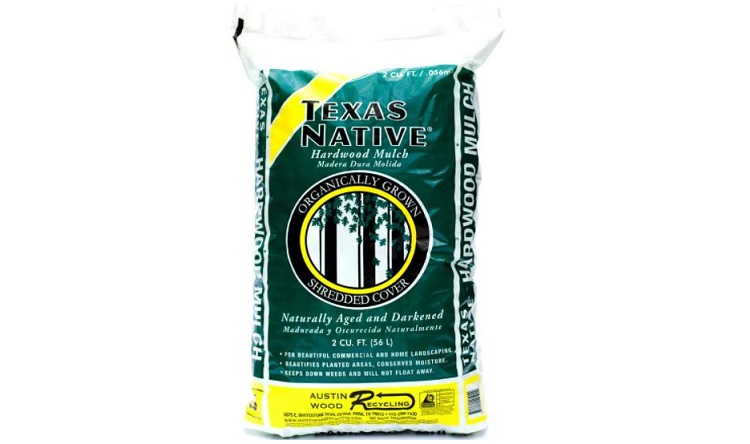
This 100% natural hardwood mulch strikes the right balance of value, quality, and use. It’s a vivid brown color obtained through a natural aging process that adds no dyes or chemicals. This produces a natural pigment that won’t fade out over time.
If you prefer a more conspicuous colorized option, this mulch is available in a dyed black option. The dye’s eco-friendly, non-toxic, and certified by the EPA. Either option is a cute addition to your landscaping, yard, or garden.
Best Landscaping Mulch: NuScape Black Rubber Mulch
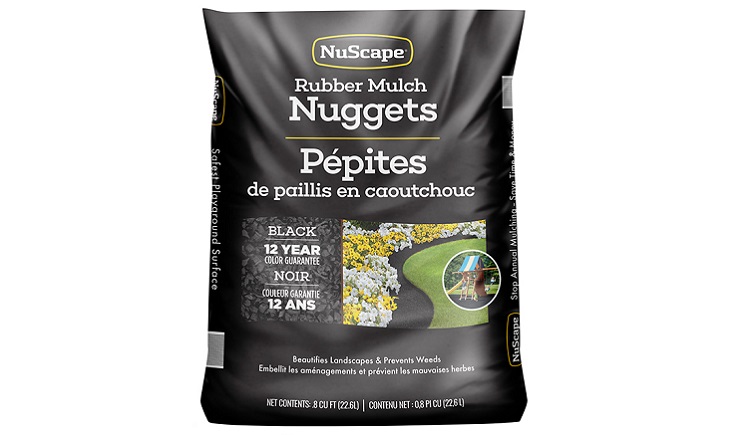
If you’re looking for a long-lasting option that won’t deteriorate or fade, look no further than rubber mulch. NuScape Black Rubber Mulch Nuggets looks like other wood-based brands but is longer-lasting, heavier, and made entirely of recycled rubber. Moreover, it provides some bounce, making it perfect for swing sets or playgrounds.
Rubber mulch is often costlier than its organic counterparts but lasts much longer. If you need a mulch that’ll serve you for years to come, you’ll really love NuScape Rubber Mulch. Be prepared to dig a bit deeper into your pocket, though.
Best Lawn Mulch: Scotts Premium Topsoil Soil Conditioner
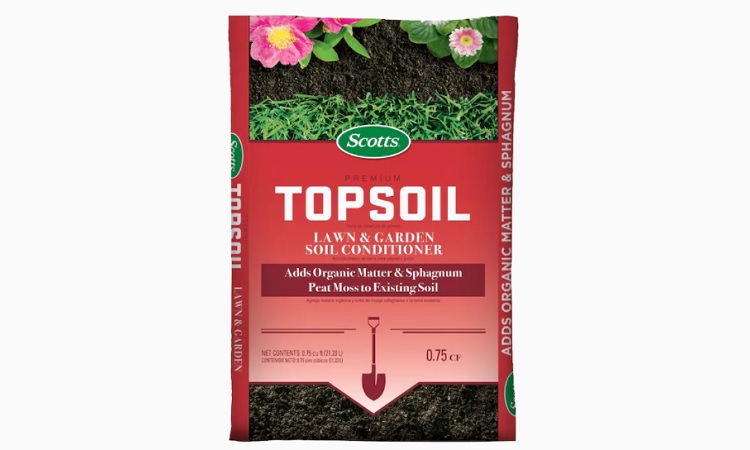
When adding mulch to your lawn, one of the main considerations is to select a product that’ll not only protect the soil but also improve it.
This is particularly important if you’re adding it to a place where grass doesn’t grow well. Scotts Topsoil Soil Conditioner is a mix of peat moss and organic soil, which helps your existing grass build strong roots.
This is the perfect option to improve bare areas in your lawn or fill in holes. If you’re starting a new garden, this is also the perfect option to smarten up the area prior to and during planting.
Bear in mind that this mulch should be applied in-ground instead of on raised beds or in containers. It doesn’t hinder weed growth in garden beds.
Best Flower Bed Mulch: Soil Blend 8 lbs. Super Compost Organic Mulch
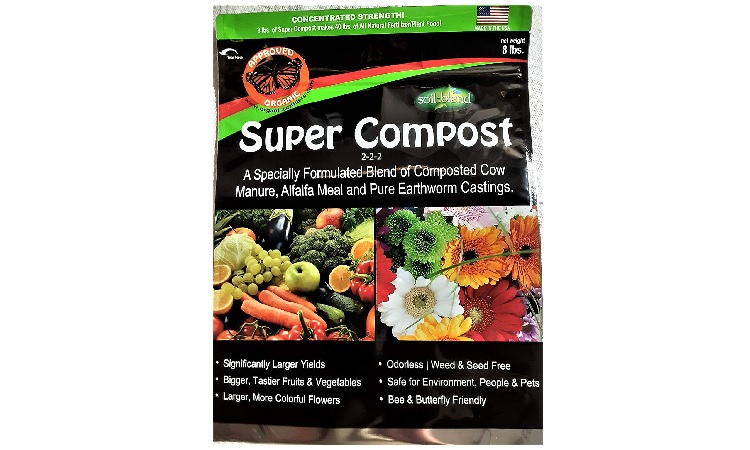
Compost is an amazing mulch for flower beds because it provides the soil with nutrients and looks attractive and neat, too. This organic mulch is made with pure earthworm castings, alfalfa meal, and cow manure.
Like other types of mulch, compost helps with moisture retention in the soil as well as temperature regulation in the soil. It also comes with the additional benefit of providing nutrients to plants, often leading to larger, more plentiful, more colorful, and longer-lasting flowers.
Best Mulch for Vegetables: CleanStraw Natural Longleaf Pine Straw Mulch
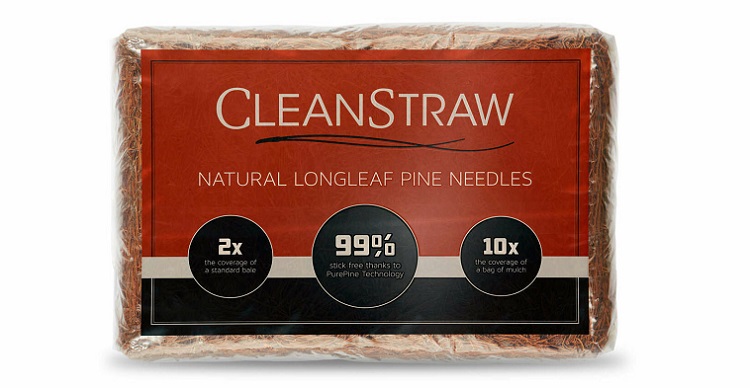
Mulch can work miracles to keep weeds away from your vegetable garden. When mulching your vegetable garden, it’s important to select a product that’s easy to maintain but not too expensive since you’ll be turning your garden over at the season’s end.
CleanStraw Longleaf Pine Straw Mulch is a good option since it lets water easily seep through to your vegetables and is inexpensive. Some weeds may still pop up, but you can easily remove them by hand if necessary. It usually has fewer possible seeds than similar alternatives, like hay or straw.
Check out how Pine Straw compares to Mulch in our full comparison here.
FAQs
Answer: The best mulches for your garden and lawn include:
• Scotts Topsoil Lawn and Garden Soil Conditioner
• Vigoro Colorized Premium Mulch
• NuScape Black Rubber Mulch Nuggets
• Texas Organic Native Hardwood Mulch
• Soil Blend 8 lbs. Super Compost Mulch
• CleanStraw Longleaf Pine Straw Mulch
• Dewitt Natural Garden Biodegradable Paper Mulch
Answer: When buying mulch, be sure to consider the following things:
• Source of mulch: Is the mulch clean and safe?
• Purpose of mulch: Which plant are you going to mulch?
Whether it’s bagged mulch or bulk much: Bagged mulch is far costlier but easier to use than bulk mulch.
• Plan ahead: Work out the area you need to mulch.
• Free mulch: Options include wood chips and fallen leaves.
Answer: Cedar mulch tends to be costlier than other mulch options, but it lasts much longer since it doesn’t easily decompose. Its oils are also known to repel insects naturally. But since this mulch lasts very long, it hardly provides the soil with any nutritional benefit.
Answer: In the right environment, stone mulches (rocks, gravel, or pebbles) can be a great option. They remain in place and don’t disintegrate.
Smaller sizes like pebbles and gravel can eventually disappear into the soil, needing touch-up applications. In that case, it’s best to use landscape fabric below stone mulches to avoid sinking.
Answer:
• Red: If you have more warm tones, golds, and terra cottas in your outdoors, red mulch can be the right option for you.
• Brown: Try brown mulch if you have a red brick home.
• Black: When used around green foliage, like sweet potato vines, black mulch really stands out. Black mulch is also perfect for gray and modern homes.
What’s the Best Mulch to Choose?
The right mulch for your landscape is one that fulfills the specific needs of your yard. Have a look at your plants to determine what kind of mulch you need.
If looks are your most important consideration, an inorganic or colored mulch could be your best option. If your main aim is to grow fruits and flowers, then organic mulch can be your best bet. Whatever the case may be, your plants are sure to thank you for deciding to mulch.

